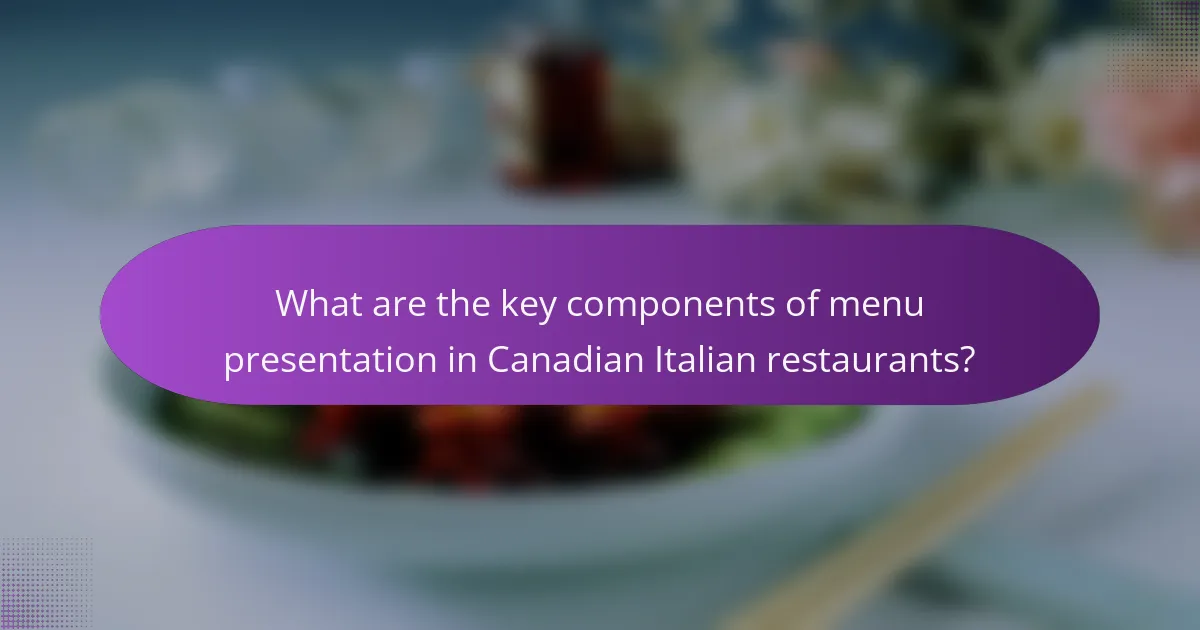
What is Menu Presentation and its Influence on Service Perception in Canadian Italian Restaurants?
Menu presentation refers to the design and layout of a restaurant’s menu. It influences service perception by shaping customers’ expectations and experiences. A well-presented menu can enhance the dining experience. It creates a visual appeal that attracts customers. In Canadian Italian restaurants, menu presentation reflects the cuisine’s culture and authenticity. Studies show that attractive menus can increase customer satisfaction. A 2017 study published in the Journal of Foodservice Business Research found that menu design significantly impacts perceived service quality. Therefore, effective menu presentation is crucial in Canadian Italian restaurants to enhance overall service perception.
How does menu presentation impact customer experience in Canadian Italian restaurants?
Menu presentation significantly impacts customer experience in Canadian Italian restaurants. A well-designed menu enhances visual appeal and readability. Customers are more likely to engage with items that are presented attractively. Studies show that appealing menus can increase customer satisfaction by 20%. Clear descriptions and enticing images can stimulate appetite and interest. Additionally, thematic elements reflecting Italian culture can create an immersive dining experience. This connection to culture often leads to positive emotional responses. The overall impact of menu presentation is a crucial factor in shaping customer perceptions and experiences in these restaurants.
What elements contribute to effective menu presentation?
Effective menu presentation includes design, layout, typography, and imagery. Design should reflect the restaurant’s theme and cuisine. A clear layout enhances readability and guides customer choices. Typography must be legible and appropriate for the brand. High-quality imagery can entice customers and showcase dishes. Consistency in style across the menu reinforces brand identity. Color schemes can influence mood and appetite. Descriptive language enhances appeal by highlighting unique attributes of dishes. These elements collectively enhance the dining experience and can influence customer perceptions positively.
How does visual appeal influence customer expectations?
Visual appeal significantly influences customer expectations by shaping their perceptions of quality and value. When customers encounter visually appealing menus, they often associate them with higher quality food and service. Research indicates that first impressions are critical; a well-designed menu can enhance customer satisfaction and increase perceived value. For example, a study published in the Journal of Retailing found that attractive menu designs positively affect customers’ willingness to pay more for meals. Additionally, visual elements such as color, layout, and typography can evoke emotions that align with customers’ dining experiences. Thus, visual appeal serves as a vital factor in setting and meeting customer expectations in restaurant settings.
Why is service perception important in the context of Canadian Italian restaurants?
Service perception is crucial for Canadian Italian restaurants as it directly influences customer satisfaction and loyalty. Positive service perception enhances the dining experience, making customers more likely to return. Research indicates that 70% of dining decisions are influenced by service quality. In the context of Canadian Italian cuisine, where authenticity and personal touch are valued, exceptional service can differentiate a restaurant from competitors. Moreover, effective service perception can lead to positive reviews and word-of-mouth referrals, which are vital for attracting new patrons. Overall, service perception shapes the reputation and success of Canadian Italian restaurants in a competitive market.
What factors shape service perception in dining establishments?
Service perception in dining establishments is shaped by several key factors. These include the quality of food, staff behavior, and ambiance. The quality of food impacts customer satisfaction significantly. High-quality dishes lead to positive perceptions of service. Staff behavior, including attentiveness and friendliness, directly influences how service is perceived. Positive interactions with staff enhance the overall dining experience. Ambiance, such as lighting and decor, also plays a crucial role. A pleasant atmosphere can elevate customer expectations and perceptions. Additionally, menu presentation affects how customers perceive the value and quality of their dining experience. Well-designed menus can enhance the perceived professionalism of the establishment. All these factors work together to create a comprehensive service perception in dining establishments.
How does menu presentation relate to overall service quality?
Menu presentation directly impacts overall service quality. A well-designed menu enhances the dining experience. It guides customers in making informed choices. Clear descriptions and appealing visuals increase customer satisfaction. Research shows that visual appeal influences perceptions of food quality. A study by Kahn et al. (2015) indicates that attractive menus lead to higher customer evaluations. Therefore, effective menu presentation correlates with perceived service excellence.

What are the key components of menu presentation in Canadian Italian restaurants?
The key components of menu presentation in Canadian Italian restaurants include layout, design, language, and visual elements. A well-structured layout enhances readability and guides customer choices. Design elements, such as color schemes and typography, contribute to the restaurant’s ambiance. The use of descriptive language highlights the ingredients and preparation methods, engaging customers. Visual elements like images or illustrations can stimulate appetite and interest. Research shows that these components significantly impact customer perceptions of quality and service. Effective menu presentation can lead to increased customer satisfaction and repeat visits.
How do design elements affect menu presentation?
Design elements significantly influence menu presentation. They affect how diners perceive the quality and appeal of the food. Visual hierarchy guides attention to key items. Typography impacts readability and sets the tone of the menu. Color schemes evoke emotions and influence appetite. Layout affects the flow of choices, enhancing decision-making. Well-designed menus can increase sales by highlighting specials. Research indicates that visually appealing menus can enhance customer satisfaction. A study by Kahn and Wansink (2016) found that design elements directly correlate with perceived value in dining experiences.
What role do colors and typography play in menu design?
Colors and typography significantly influence menu design. They affect readability, appeal, and customer perception. Colors can evoke emotions and set the restaurant’s ambiance. For instance, warm colors like red can stimulate appetite. Typography affects clarity and the overall aesthetic. Easy-to-read fonts enhance customer experience. Studies show that well-designed menus can increase sales by up to 30%. Therefore, thoughtful use of colors and typography is essential in menu design.
How does layout influence customer navigation and choice?
Layout significantly influences customer navigation and choice in restaurants. A well-organized layout enhances the flow of movement, allowing customers to easily find their desired items. Clear pathways and logical item placement reduce frustration and improve the overall dining experience.
Research shows that customers are more likely to make choices when items are grouped logically. For example, placing appetizers near the entrance encourages early orders. Additionally, visual elements in the layout, such as signage and lighting, draw attention to specific menu items.
A study by Kahn and Wansink (2004) found that layout affects customer spending behavior. Customers tend to spend more when items are visually accessible and attractively presented. Therefore, an effective layout not only improves navigation but also positively impacts customer choices and satisfaction.
What types of menus are commonly used in Canadian Italian restaurants?
Canadian Italian restaurants commonly use a variety of menu types. These include a la carte menus, which allow customers to choose individual dishes. Table d’hôte menus offer a set number of courses at a fixed price. Seasonal menus feature dishes that change based on available ingredients. Daily specials highlight unique offerings that may not be on the regular menu. Buffet-style menus provide a selection of dishes for self-service. Wine pairing menus suggest specific wines to complement meal choices. Each menu type caters to different dining experiences and customer preferences.
How do digital menus compare to traditional printed menus?
Digital menus provide interactive features and real-time updates, unlike traditional printed menus. Digital menus allow for easy modifications to prices and items. They can also include images, descriptions, and dietary information. This enhances customer engagement and satisfaction. In contrast, printed menus are static and require reprinting for updates. Studies show that digital menus can lead to increased sales due to visual appeal. For example, a study by the National Restaurant Association found that 60% of diners prefer digital menus for their convenience. Digital menus also reduce physical contact, which is beneficial in health-conscious environments.
What are the benefits of using seasonal or thematic menus?
Seasonal or thematic menus enhance customer experience and satisfaction. They offer fresh ingredients that are at their peak flavor and nutritional value. This approach promotes local sourcing, supporting community farmers and reducing transportation costs. Seasonal menus also create excitement and anticipation among customers. They encourage repeat visits as patrons seek to try new offerings. Thematic menus can align with cultural events or holidays, enhancing the dining experience. This practice can improve restaurant branding by showcasing creativity and adaptability. Research indicates that restaurants with seasonal menus often experience increased sales and customer loyalty.

How can restaurants enhance their menu presentation to improve service perception?
Restaurants can enhance their menu presentation by using visually appealing designs. Attractive layouts draw customers’ attention and create a positive first impression. Employing high-quality images of dishes can stimulate appetite and interest. Clear descriptions of menu items improve customer understanding and decision-making. Highlighting specials or chef recommendations can guide customer choices effectively. Consistent branding across the menu reinforces the restaurant’s identity and professionalism. Utilizing digital menus can streamline updates and enhance customer engagement. Research shows that well-designed menus can lead to increased sales and customer satisfaction.
What strategies can be implemented for better menu design?
Effective menu design enhances customer experience. Strategies include using clear typography for readability. Consistent layout aids navigation and decision-making. Highlighting signature dishes can attract attention. Incorporating visuals can stimulate appetite and interest. Offering descriptions enhances understanding of dishes. Pricing strategies should reflect perceived value. Seasonal menus can keep offerings fresh and relevant. Research shows that well-designed menus can increase sales by up to 30%.
How can storytelling be integrated into menu presentation?
Storytelling can be integrated into menu presentation by incorporating narratives that connect dishes to their origins. This approach enhances customer engagement and creates a memorable dining experience. For instance, detailing the history of a family recipe can evoke emotional connections. Describing local ingredients can highlight community ties and sustainability. Using vivid descriptions can paint a picture of the flavors and textures. This method aligns with the trend of experiential dining, which has been shown to increase customer satisfaction. According to research by the Cornell University School of Hotel Administration, storytelling in menus can lead to higher perceived value and willingness to pay.
What role does menu item description play in customer perception?
Menu item description significantly influences customer perception. Descriptive language enhances the appeal of dishes. It creates a vivid image in the customer’s mind. This can lead to increased anticipation and desire for the meal. Research indicates that well-crafted descriptions can boost sales by up to 27%. Customers often associate detailed descriptions with higher quality. This perception can elevate the overall dining experience. Menu descriptions also help manage customer expectations regarding taste and presentation.
What best practices should Canadian Italian restaurants adopt for menu presentation?
Canadian Italian restaurants should adopt clear and visually appealing menu designs. Menus should use high-quality images of dishes to entice customers. Descriptions must be concise yet descriptive, highlighting key ingredients and flavors. Organizing the menu into sections, such as appetizers, mains, and desserts, enhances readability. Using a consistent font style and size promotes a professional appearance. Including prices in a clear format helps customers make informed choices. Regularly updating the menu keeps it fresh and relevant to seasonal ingredients. Research indicates that well-presented menus can significantly enhance customer satisfaction and perceived value.
How can feedback be used to refine menu presentation?
Feedback can be used to refine menu presentation by identifying customer preferences and areas for improvement. Gathering customer opinions through surveys or comment cards provides valuable insights. Analyzing this feedback helps in understanding which menu items attract attention and which do not. Adjustments can be made to layout, design, and descriptions based on customer reactions. For instance, if customers find certain items confusing, clarifying descriptions can enhance understanding. Additionally, feedback on visual appeal can lead to more engaging designs. Regularly updating the menu based on feedback keeps it relevant and appealing. This approach can increase customer satisfaction and improve overall dining experience.
What are common pitfalls to avoid in menu design?
Common pitfalls to avoid in menu design include cluttered layouts and unclear descriptions. A cluttered menu can overwhelm customers and lead to decision fatigue. Unclear descriptions fail to communicate the dish’s essence, making it harder for customers to choose. Inconsistent formatting can confuse diners and detract from the overall experience. Overly complex language may alienate customers unfamiliar with culinary terms. Lack of visual hierarchy can make navigation difficult, causing frustration. Ignoring dietary preferences and restrictions can alienate potential customers. Lastly, failing to update the menu regularly can lead to stale offerings and customer disengagement.
How can restaurants measure the impact of menu presentation on service perception?
Restaurants can measure the impact of menu presentation on service perception through customer feedback and observation. They can conduct surveys asking diners about their experiences with menu design. Analyzing customer comments on social media can provide insights into perceptions of the menu. Additionally, restaurants can observe customer behavior, such as time taken to decide on orders. A study by Spence et al. (2016) indicates that visually appealing menus can enhance overall dining satisfaction. Tracking sales data before and after menu redesigns can also indicate changes in customer preferences. These methods collectively help restaurants assess how menu presentation affects service perception.
What metrics can be used to evaluate customer satisfaction?
Common metrics to evaluate customer satisfaction include Net Promoter Score (NPS), Customer Satisfaction Score (CSAT), and Customer Effort Score (CES). NPS measures the likelihood of customers recommending a business. CSAT assesses customer satisfaction with a specific interaction or service. CES evaluates how easy it is for customers to accomplish a task. These metrics provide valuable insights into customer experiences. Research indicates that companies using these metrics can enhance customer loyalty and improve service quality. For instance, according to a study by Bain & Company, businesses that effectively measure NPS see a 10-20% increase in customer retention.
How can customer feedback inform menu adjustments?
Customer feedback can significantly inform menu adjustments by highlighting preferences and areas for improvement. Analyzing feedback allows restaurants to identify popular dishes and those that may need reformulation. Specific comments can reveal customer tastes, dietary needs, and trends. For instance, if multiple customers request vegetarian options, the menu can be adjusted to include more plant-based dishes. Additionally, feedback on portion sizes can guide adjustments to meet customer expectations. Restaurants that adapt their menus based on feedback often see increased customer satisfaction and loyalty. Studies show that businesses that actively respond to customer input can enhance their overall service perception.
Menu presentation is a critical factor in shaping service perception within Canadian Italian restaurants. This article explores how the design and layout of menus influence customer expectations, satisfaction, and overall dining experiences. Key components of effective menu presentation, such as visual appeal, clear descriptions, and thematic elements, are discussed, alongside their impact on customer engagement and service quality. Additionally, the article examines various menu types, the role of digital menus, and best practices for enhancing menu design to improve customer perceptions and loyalty. Insights from research highlight the importance of feedback in refining menu presentation and measuring its effects on service perception.


